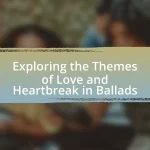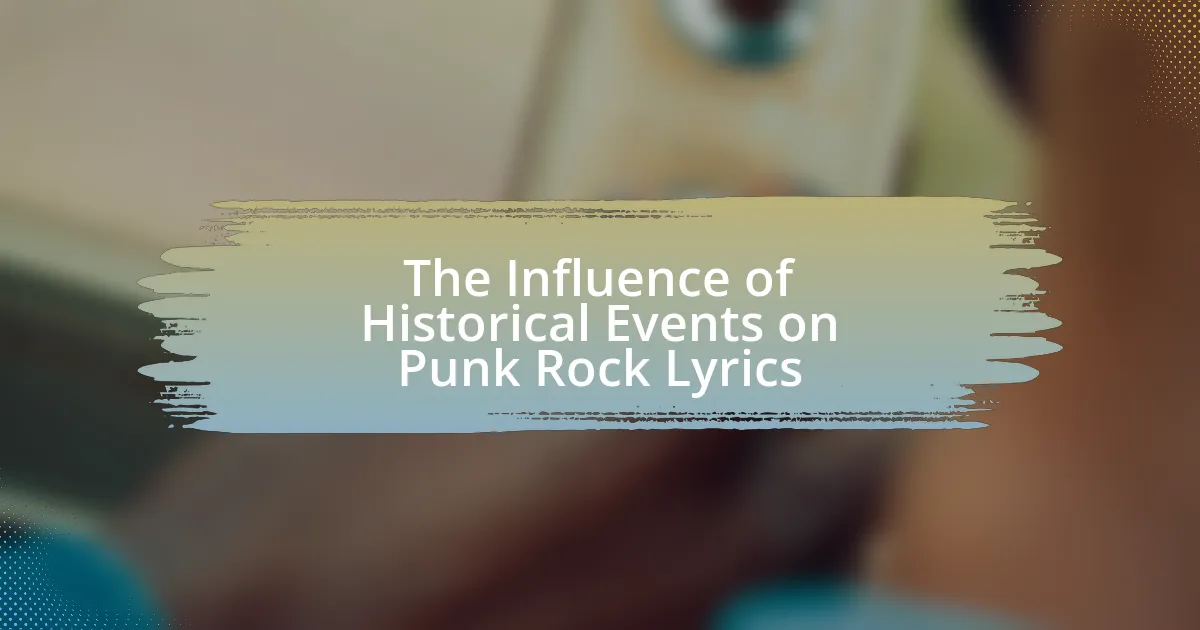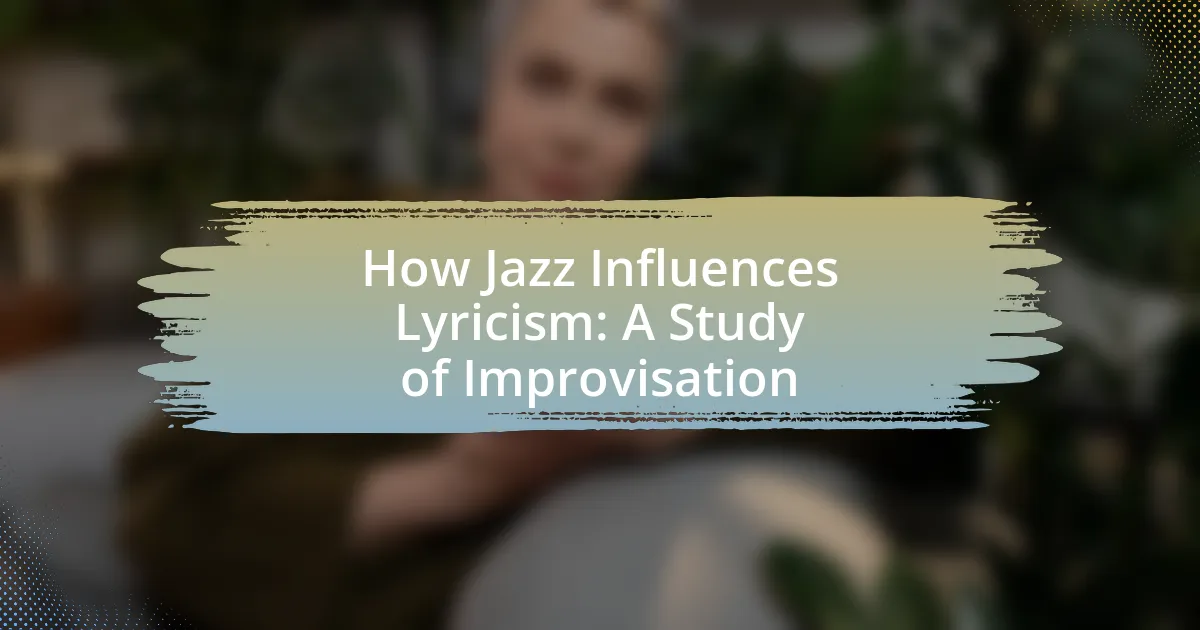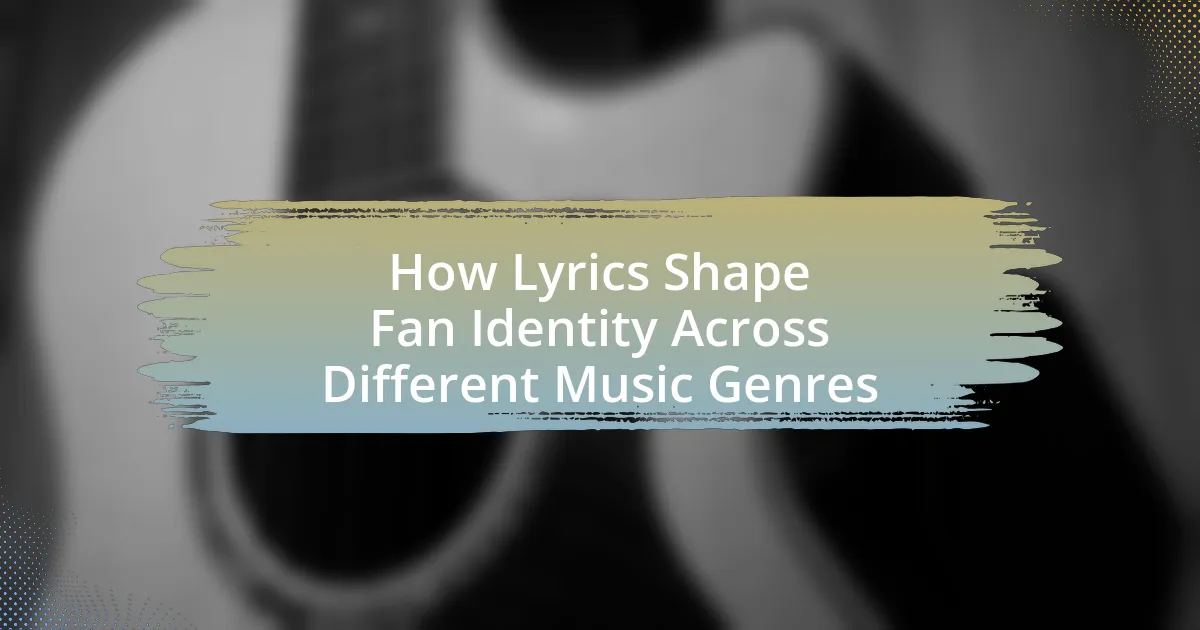Gender representation in contemporary lyrics examines how different genders are portrayed in modern music, reflecting societal attitudes and norms. The article discusses the key elements of gender representation, including the roles assigned to male and female characters, the language used, and the power dynamics illustrated in lyrics. It highlights the importance of analyzing these representations to understand their impact on societal perceptions and the ongoing conversation about gender equality in the music industry. Additionally, the article explores current trends, challenges faced by female artists, and the influence of cultural context on gender representation across various music genres.

What is Gender Representation in Contemporary Lyrics?
Gender representation in contemporary lyrics refers to the portrayal and roles of different genders within modern song lyrics, reflecting societal attitudes and norms. This representation often highlights themes such as empowerment, objectification, and gender stereotypes, with artists using their platforms to challenge or reinforce these narratives. For instance, a study by the Annenberg Inclusion Initiative found that only 22.5% of popular songs featured female artists, indicating a significant gender imbalance in representation. Additionally, lyrics from genres like hip-hop and pop frequently depict women in sexualized roles, while male artists often embody themes of dominance and power. This disparity underscores the ongoing conversation about gender equality and representation in the music industry.
How is gender representation defined in the context of lyrics?
Gender representation in the context of lyrics is defined as the portrayal and depiction of different genders within song lyrics, reflecting societal norms, stereotypes, and power dynamics. This representation can manifest through the roles assigned to male and female characters, the language used, and the themes explored, often revealing underlying attitudes towards gender. For instance, studies have shown that female characters in popular music are frequently depicted in passive roles, while male characters are often portrayed as dominant, highlighting a disparity in representation that mirrors broader societal trends.
What are the key elements that constitute gender representation in lyrics?
Key elements that constitute gender representation in lyrics include the portrayal of gender roles, the use of language and imagery, and the expression of power dynamics. Gender roles are often depicted through the actions and characteristics assigned to male and female figures in the lyrics, reflecting societal norms and expectations. Language and imagery play a crucial role in shaping perceptions of gender, as certain words and phrases can reinforce stereotypes or challenge them. Additionally, power dynamics are illustrated through the relationships and interactions between genders, highlighting issues such as dominance, submission, and equality. Research indicates that these elements significantly influence listeners’ perceptions of gender, as seen in studies analyzing popular music lyrics over the past few decades.
How does cultural context influence gender representation in lyrics?
Cultural context significantly influences gender representation in lyrics by shaping the themes, language, and roles attributed to different genders. For instance, in societies with traditional gender roles, lyrics often reflect stereotypes, portraying women as submissive or men as dominant, which reinforces existing societal norms. Research by the University of Southern California found that in genres like country music, male artists frequently depict women in limited roles, while female artists often challenge these representations, reflecting a shift in cultural attitudes towards gender equality. This dynamic illustrates how cultural context not only informs the content of lyrics but also impacts the reception and interpretation of gender roles within music.
Why is analyzing gender representation in lyrics important?
Analyzing gender representation in lyrics is important because it reveals societal attitudes towards gender roles and identities. Lyrics often reflect and shape cultural norms, influencing listeners’ perceptions of gender. For instance, a study by the University of Southern California found that female artists are often portrayed in stereotypical roles, which can perpetuate harmful gender norms. By examining these representations, researchers can identify patterns of inequality and advocate for more equitable portrayals in music, ultimately contributing to broader discussions on gender equality in society.
What impact does gender representation have on societal perceptions?
Gender representation significantly influences societal perceptions by shaping norms, attitudes, and behaviors regarding gender roles. When media, including contemporary lyrics, portray diverse and equitable gender representations, they can challenge stereotypes and promote a more inclusive understanding of gender identity. For instance, research by the Geena Davis Institute on Gender in Media indicates that female characters in media are often underrepresented, which can lead to the reinforcement of traditional gender roles and limit societal expectations of women. Conversely, positive representation can empower individuals and foster acceptance, as seen in the increasing visibility of LGBTQ+ artists in music, which has contributed to broader societal acceptance of diverse sexual orientations and gender identities.
How can lyrics reflect or challenge gender stereotypes?
Lyrics can reflect or challenge gender stereotypes by portraying traditional gender roles or subverting them through their themes and narratives. For instance, many pop and hip-hop songs reinforce stereotypes by depicting women primarily as objects of desire or men as dominant figures. Conversely, artists like Beyoncé in “Flawless” and Taylor Swift in “The Man” explicitly challenge these norms by promoting empowerment and equality, thereby reshaping societal perceptions of gender. Research indicates that music can influence listeners’ attitudes towards gender roles, as highlighted in a study published in the Journal of Gender Studies, which found that songs with progressive messages can lead to more egalitarian views among audiences.

What are the current trends in gender representation in contemporary lyrics?
Current trends in gender representation in contemporary lyrics show a significant shift towards more diverse and empowered portrayals of women and non-binary individuals. Female artists increasingly express autonomy, challenge traditional gender roles, and address issues such as sexual agency and mental health, as seen in songs by artists like Lizzo and Billie Eilish. Additionally, there is a growing presence of male artists who advocate for gender equality and emotional vulnerability, exemplified by tracks from artists like Hozier and Sam Smith. Research indicates that the representation of women in popular music has improved, with a 2021 study by the Annenberg Inclusion Initiative revealing that 48.5% of songs featured female artists, up from 30% in previous years. This trend reflects a broader cultural movement towards inclusivity and the dismantling of stereotypes in the music industry.
How do different genres of music approach gender representation?
Different genres of music approach gender representation in distinct ways, often reflecting cultural norms and societal attitudes. For instance, pop music frequently emphasizes themes of empowerment and independence for women, as seen in songs by artists like Beyoncé and Taylor Swift, who advocate for female strength and autonomy. In contrast, hip-hop has historically faced criticism for its portrayal of women, often objectifying them, although recent artists like J. Cole and Kendrick Lamar have begun to challenge these stereotypes by addressing issues of respect and equality. Rock music has varied representations, with female artists like Joan Jett and Paramore’s Hayley Williams breaking gender norms and asserting their identities, while some classic rock songs perpetuate traditional gender roles. Country music often reflects traditional values, with narratives that can either reinforce or challenge gender stereotypes, as seen in the works of artists like Kacey Musgraves, who critiques societal expectations. Overall, the approach to gender representation in music genres is influenced by historical context, artist intent, and audience reception, leading to a complex landscape of representation.
What are the notable differences in gender representation across genres?
Notable differences in gender representation across genres include the prevalence of male artists in rock and country music, while pop and R&B genres often feature a more balanced or even female-dominated representation. For instance, a study by the Annenberg Inclusion Initiative found that in 2019, only 21.7% of artists in the rock genre were women, compared to 48.5% in pop music. Additionally, hip-hop has seen a rise in female representation, with artists like Nicki Minaj and Cardi B gaining prominence, yet still, the genre remains male-dominated overall. These statistics illustrate the varying degrees of gender representation, highlighting significant disparities across different musical genres.
How do artists use their platform to address gender issues in their lyrics?
Artists use their platform to address gender issues in their lyrics by incorporating themes of empowerment, equality, and social critique. For instance, many musicians write about personal experiences related to gender discrimination, highlighting the struggles faced by marginalized groups. This approach not only raises awareness but also fosters dialogue around gender equality. A notable example is Beyoncé’s song “Flawless,” which includes a sample of Chimamanda Ngozi Adichie’s TED Talk on feminism, directly promoting the conversation about women’s rights. Additionally, artists like Taylor Swift and Halsey have used their lyrics to challenge traditional gender roles and advocate for LGBTQ+ rights, further emphasizing the importance of representation in music. These lyrical choices reflect broader societal issues and encourage listeners to engage with gender-related topics critically.
What role do female artists play in shaping gender representation?
Female artists play a crucial role in shaping gender representation by challenging stereotypes and promoting diverse narratives through their work. They often use their platforms to address issues such as sexism, body image, and empowerment, thereby influencing societal perceptions of gender. For instance, artists like Beyoncé and Lizzo have redefined femininity and body positivity in their music and public personas, encouraging acceptance and self-love among their audiences. Research indicates that female musicians significantly impact listeners’ attitudes toward gender roles, as seen in studies that link exposure to female-led music with increased support for gender equality.
How has the rise of female artists influenced lyrical content?
The rise of female artists has significantly influenced lyrical content by introducing diverse perspectives and themes that challenge traditional gender norms. Female artists often address issues such as empowerment, sexuality, and personal experiences, which were historically underrepresented in mainstream music. For example, artists like Beyoncé and Lizzo have popularized themes of body positivity and self-acceptance, reshaping the narrative around women’s identities in music. Additionally, studies indicate that songs by female artists tend to feature more emotional depth and vulnerability, contrasting with the often aggressive or superficial themes prevalent in male-dominated genres. This shift not only broadens the scope of lyrical content but also encourages a more inclusive dialogue about gender and identity in contemporary music.
What challenges do female artists face in the music industry regarding representation?
Female artists face significant challenges in the music industry regarding representation, primarily due to systemic gender bias and underrepresentation in key decision-making roles. Research indicates that women make up only about 21% of artists in the Billboard Hot 100, highlighting their marginalization in mainstream music. Additionally, female artists often encounter stereotypes that limit their creative expression, as they are frequently pigeonholed into specific genres or roles, such as pop or romantic themes, rather than being recognized for their diverse talents. Furthermore, studies show that women are less likely to be featured in music videos or receive airtime on radio stations, which further perpetuates their invisibility in the industry. These factors collectively contribute to a challenging environment for female artists striving for equitable representation in a male-dominated landscape.

How can we critically analyze gender representation in contemporary lyrics?
To critically analyze gender representation in contemporary lyrics, one must examine the themes, language, and imagery used in the lyrics to identify how gender roles and identities are portrayed. This analysis can reveal whether the lyrics reinforce traditional gender stereotypes or challenge them, as seen in the works of artists like Beyoncé and Taylor Swift, who often address issues of female empowerment and gender equality. Research indicates that lyrics reflecting progressive gender representation can influence societal perceptions, as demonstrated in a study by the University of Southern California, which found that songs promoting gender equality positively impact listeners’ attitudes towards gender roles.
What methodologies can be used for analyzing lyrics?
Qualitative content analysis and thematic analysis are methodologies commonly used for analyzing lyrics. Qualitative content analysis involves systematically categorizing and interpreting the content of lyrics to identify patterns and themes, while thematic analysis focuses on recognizing and analyzing recurring themes within the lyrics. Both methodologies allow researchers to explore the representation of gender by examining language, imagery, and narrative structures present in the lyrics. For instance, a study by Kearney (2019) in “Gender and Music” highlights how thematic analysis can reveal underlying gender stereotypes in popular music lyrics, demonstrating the effectiveness of these methodologies in understanding gender representation.
How do qualitative and quantitative methods differ in analyzing lyrics?
Qualitative and quantitative methods differ significantly in analyzing lyrics. Qualitative methods focus on subjective interpretation, exploring themes, emotions, and cultural contexts within the lyrics, often through techniques like thematic analysis or close reading. For instance, a qualitative analysis might examine how female empowerment is portrayed in a specific song, interpreting the language and imagery used.
In contrast, quantitative methods employ statistical analysis to measure specific elements within the lyrics, such as word frequency, sentiment scores, or the prevalence of gendered language. For example, a quantitative study might analyze a large dataset of contemporary lyrics to determine the percentage of songs that feature female protagonists versus male protagonists, providing numerical evidence of gender representation trends.
These differences highlight how qualitative methods provide depth and context, while quantitative methods offer measurable insights, allowing for a comprehensive understanding of gender representation in contemporary lyrics.
What tools and frameworks are available for lyric analysis?
Tools and frameworks available for lyric analysis include Natural Language Processing (NLP) libraries such as NLTK, SpaCy, and TextBlob, which facilitate text processing and sentiment analysis. Additionally, frameworks like LIWC (Linguistic Inquiry and Word Count) provide insights into emotional and cognitive dimensions of lyrics. These tools enable researchers to quantify language use, identify themes, and analyze gender representation effectively. For instance, LIWC has been validated in various studies for its ability to assess psychological states through language, making it a reliable choice for analyzing gender representation in contemporary lyrics.
What are some examples of effective gender representation in lyrics?
Effective gender representation in lyrics can be seen in songs like “Run the World (Girls)” by Beyoncé, which empowers women by celebrating their strength and independence. Another example is “If I Were a Boy,” also by Beyoncé, which explores gender roles and the emotional experiences of men and women, prompting listeners to reflect on societal expectations. Additionally, “Just a Girl” by No Doubt critiques traditional gender stereotypes by highlighting the limitations placed on women. These songs illustrate how artists use their platforms to challenge norms and promote gender equality through their lyrics.
Which songs or artists exemplify positive gender representation?
Songs and artists that exemplify positive gender representation include “Run the World (Girls)” by Beyoncé and “Just a Girl” by No Doubt. Beyoncé’s song promotes female empowerment and independence, celebrating women’s strength and resilience. Similarly, No Doubt’s “Just a Girl” critiques gender stereotypes and highlights the limitations placed on women, encouraging self-identity and freedom. Both songs have received critical acclaim for their messages, with Beyoncé’s track becoming an anthem for feminism and social movements, while No Doubt’s song has been recognized for its cultural impact in challenging traditional gender roles.
How can these examples serve as models for future lyrical content?
These examples can serve as models for future lyrical content by showcasing diverse gender representations and challenging traditional stereotypes. By incorporating themes of empowerment, vulnerability, and authenticity, these lyrics can inspire new artists to explore complex narratives that resonate with a broader audience. For instance, songs that depict women’s experiences in a multifaceted manner, such as those by artists like Lizzo and Billie Eilish, highlight the importance of individuality and self-acceptance. This approach not only reflects contemporary societal shifts but also encourages future lyricists to embrace inclusivity and authenticity in their work, ultimately fostering a richer and more varied musical landscape.
What practical tips can be applied when analyzing gender representation in lyrics?
To analyze gender representation in lyrics effectively, focus on identifying the roles and characteristics attributed to different genders within the text. Examine the frequency of gendered pronouns and descriptors, as well as the context in which they are used, to understand how gender dynamics are portrayed. For instance, a study by the University of Southern California found that female artists often face stereotypical roles compared to their male counterparts, which can be quantified by analyzing the language used in their lyrics. Additionally, consider the themes present in the lyrics, such as empowerment or objectification, to assess the overall representation of gender. This approach allows for a nuanced understanding of how gender is constructed and perceived in contemporary music.





